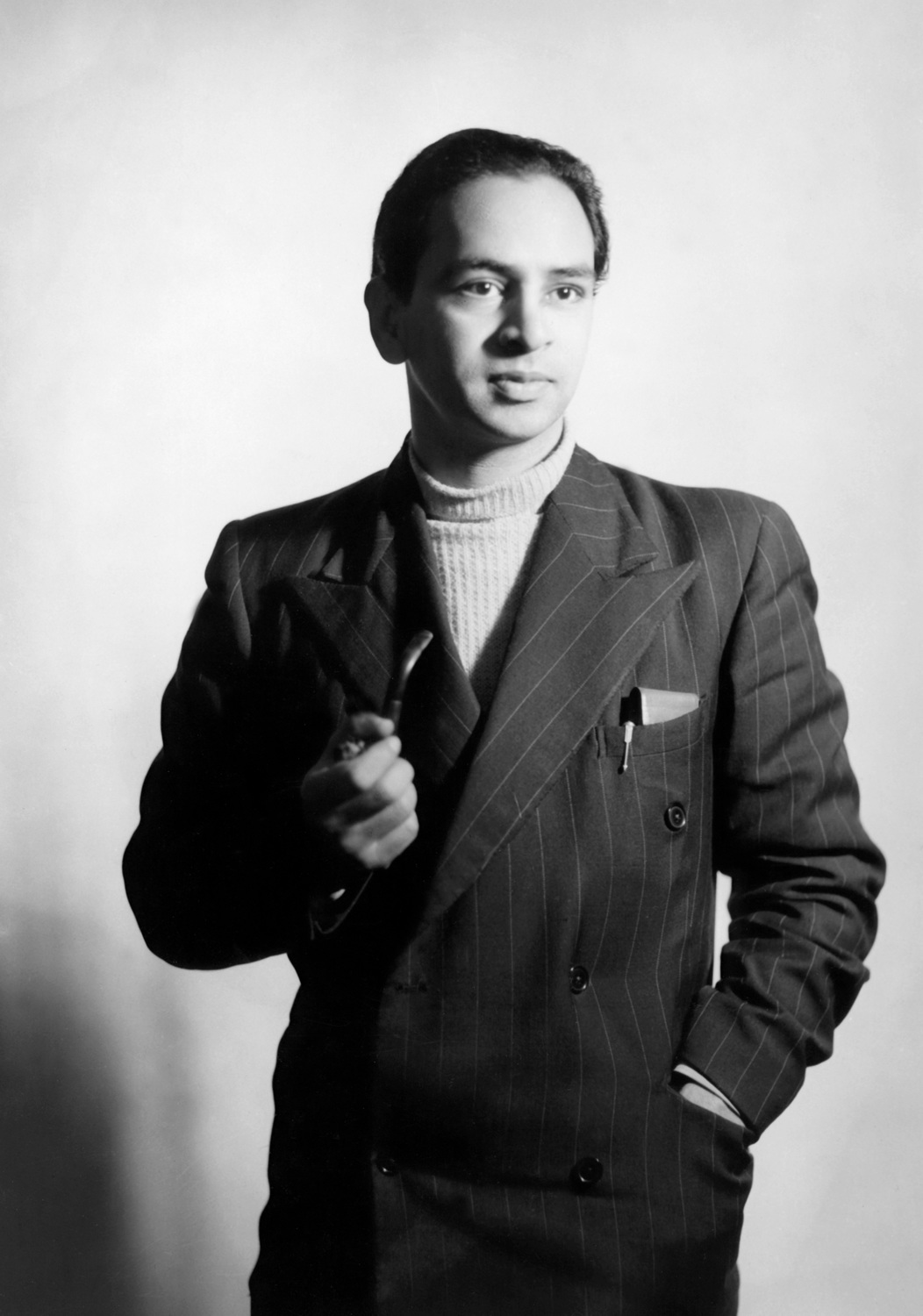Archive
Mulk Raj Anand
- Mulk
- Raj
- Anand
- 12-12-1905
- Peshāwar (PK)
- 28-09-2004
- Pune (IN)
- WriterPhilosopherArt PatronCultural Critic
As a global socialist and modernist, Mulk Raj Anand sought and shaped opportunities for intellectual exchanges between Asia and Europe.
Word Count: 20

Mulk Raj Anand by Howard Coster, half-plate film negative, 1930s (© National Portrait Gallery, London). 
Paperback cover of Untouchable by Mulk Raj Anand Preface by E.M., 34pp., Forster, Bombay: Kutub-Popular, around 1953 (© Kutub-Popular). 
Mulk Raj Anand in his late years at Taraporevala Mansion. 25 Cuffe Parade. Photograph: Dolly Sahiar (reproduced with the permission of The Marg Foundation, Mumbai, India/ Taken from Garimella 2005, 9). Bluemel, Kristin. “Introduction in the Space between Modernisms George Orwell and the Radical Eccentrics.” George Orwell and the Radical Eccentrics: Intermodernism in Literary London, by Kristin Bluemel, Palgrave Macmillan US, 2004, pp. 1–25.
Dalvi, Mustansir. “Mulk and Modern Indian Architecture.” Mulk Raj Anand: Shaping the Indian Modern, edited by Annapurna Garimella, Marg Publications, 2005, pp. 56–65.
Deboo, Khorshed. “Revisiting the Past, Reimagining a Future. How an Art Magazine Found a Place in Indiaʼs Nation-Building Narratives.” Himal Southasian, 16 February 2021, www.himalmag.com/revisiting-the-past-reimagining-a-future-2021/. Accessed 20 March 2021.
Hoskote, Ranjit. “The Last of Indian English Fictionʼs Grand Troika.” The Hindu. Online Edition of Indiaʼs National Newspaper, 28 September 2004, www.hindu.com/2004/09/29/stories/2004092904171100.htm. Accessed 20 March 2021.
Kapur, Geeta. “Partisan Modernity.” Mulk Raj Anand: Shaping the Indian Modern, edited by Annapurna Garimella, Marg Publications, 2005, pp. 56–65.
Lee, Rachel, and Kathleen James-Chakraborty. “Marg Magazine: A Tryst with Architectural Modernity.” ABE Journal, no. 1, May 2012. abe.revues.org, doi: 10.4000/abe.623. Accessed 20 March 2021.
Loomba, Ania. Revolutionary Desires: Women, Communism, and Feminism in India. Routledge, 2019.
Morse, Daniel Ryan. “An ‘Impatient Modernist’: Mulk Raj Anand at the BBC.” Modernist Cultures, vol. 10, no. 1, March 2015, pp. 83–98.
Nasta, Susheila. “Between Bloomsbury and Gandhi? The Background to the Publication and Reception of Mulk Raj Anandʼs Untouchable.” Books Without Borders, Volume 2: Perspectives from South Asia, edited by Robert Fraser and Mary Hammond, Palgrave Macmillan UK, 2008, pp. 151–69. Springer Link, doi: 10.1057/9780230289130_11. Accessed 20 March 2021.
Parimoo, Rathan. “Remembering Mulk Raj Anand.” Mulk Raj Anand: Shaping the Indian Modern, edited by Annapurna Garimella, Marg Publications, 2005, pp. 42–49.
Saha, Amit Shankar. “Perspective: Exile Literature and the Diasporic Indian Writer.” Rupkatha Journal on Interdisciplinary Studies in Humanities, vol. 1, no. 2, Autumn 2009, www.rupkatha.com/0102exileliteratureanddiasporicindianwriter.pdf. Accessed 20 March 2021.
Sales-Pontes, Alzira Hilda. Dr. Mulk Raj Anand – A Critical Bibliography (Doctoral thesis, Loughborough University Of Technology, 1985), https://hdl.handle.net/2134/10854. Accessed 20 March 2021.
Satchidanandan, Koyamparambath. “Mulk Raj Anand: A Creator with Social Concern.” Frontline, vol. 21, no. 21, October 2004, pp. 9–22.
Verma, K.D. “Mulk Raj Anand: A Reappraisal.” Idem. The Indian Imagination: Critical Essays on Indian Writing in English, Palgrave Macmillan US, 2000, pp. 83–103. Springer, doi: 10.1007/978-1-349-61823-1_5. Accessed 20 March 2021.
Viswanathan, Rashmi. “Mulk Raj Anand.” 20 February 2019, Post. Notes on Art in a Global Context, https://post.moma.org/mulk-raj-anand/. Accessed 20 March 2021.
Word Count: 359
Marg, Marg Publications, https://marg-art.org/.
Word Count: 6
We would like to thank Marg (Anjana Premchand, Mrinalini Vasudevan) for their support of our research.
Word Count: 16
8 St George's Mews Regent's Park Road, Primrose Hill, London, NW1 8XE (residence); 25 Cuffe Parade, Bombay (now Captain Prakash Pethe Marg), Colaba, Mumbai (residence and office).
- Bombay
- Rachel Lee; Mareike Schwarz. "Mulk Raj Anand." METROMOD Archive, 2021, https://archive.metromod.net/viewer.p/69/2951/object/5138-7554744, last modified: 15-09-2021.
-
Rudolf von LeydenGeologistAdvertisement SpecialistJournalistArt CriticArt CollectorCartoonistBombay
The advertisement expert, Rudolf von Leyden, became a major art critic and art historian in Bombay in the 1940s, advocating an urgent need for modernism in art in post-colonial India.
Word Count: 30
Emanuel SchlesingerFactory OwnerTechnical DirectorArt CollectorArt CriticBombayThe art collector Schlesinger provided primarily financial aid by creating working opportunities for young artists in post-independence Bombay, and initiated the corporate culture of buying art.
Word Count: 26
Homi Jehangir BhabhaScientistCollectorArtistBombayHomi Jehangir Bhabha was a world class scientist, institution builder, an artist and art connoisseur. His vision for growth of science and art has had significant impact in post-colonial India.
Word Count: 30
Minnette De SilvaArchitectJournalistBombayProbably the first Sri Lankan woman architect and a founding member of Marg, Minnette De Silva mediated between tradition and modernity while defying the boundaries of gender, caste and disciplines.
Word Count: 30
Ernst N. SchaefferJournalistPhotojournalistTour GuideEditorRadio ModeratorNewspaper CorrespondentBombayIn exile Ernst Schaeffer diversified his journalistic practice and developed an understanding of Bombay through walking the city streets, taking on street-level-photography and photojournalism.
Word Count: 24
Marg. A Magazine of Architecture and ArtMagazineBombayLocal and exiled creatives formed the Modern Architectural Research Group to publish a progressive journal of art and architecture in Bombay from 1946 onwards.
Word Count: 23
Iconic Photo of the Progressive Artists’ Group and Their AssociatesPhotographBombayThere are two versions of the PAG photo at the opening of M.F. Husain's first solo exhibition in 1950 (published in 1996 and 2003) and two narratives about the opening.
Word Count: 28
Open Studio Evenings by Käthe and Walter LanghammerSalonBombayThe painter Walter Langhammer and his wife Käthe built an informal infrastructure to promote local avant-garde artists and regularly invited them to Open Studio Evenings at their studio.
Word Count: 29